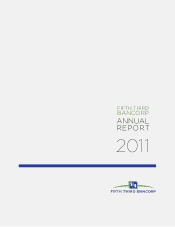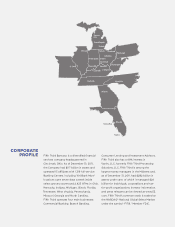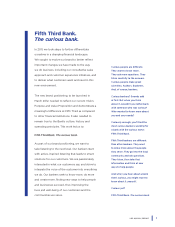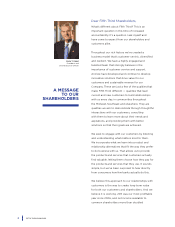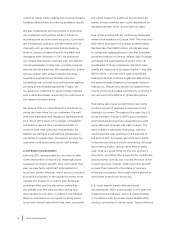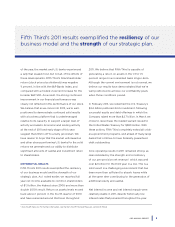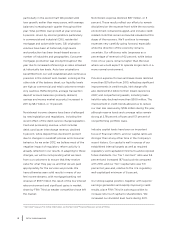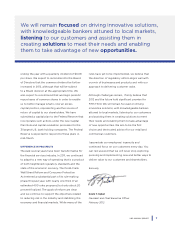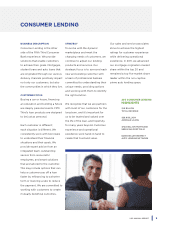Fifth Third Bank 2011 Annual Report Download - page 8
Download and view the complete annual report
Please find page 8 of the 2011 Fifth Third Bank annual report below. You can navigate through the pages in the report by either clicking on the pages listed below, or by using the keyword search tool below to find specific information within the annual report.
6FIFTH THIRD BANCORP
particularly in the second half. We posted solid
loan growth, earlier than many peers, with average
balances increasing each quarter throughout the
year. Total portfolio loan growth at year-end was
5 percent, driven by solid originations particularly
in commercial and industrial (C&I), residential
mortgage and automobile loans. C&I origination
volumes have been at historically high levels
and production has been broad-based across a
number of industries and geographies. Consumer
mortgage production was strong throughout the
year due to increased refinancings as rates remained
at historically low levels. Auto loan originations
benefitted from our well-established and continuous
presence in the indirect auto market. Looking at the
other side of the balance sheet, our liquidity levels
are high as commercial and retail customers remain
very cautious. Reflecting this, average transaction
deposit account balances (primarily demand,
savings and money market accounts) increased in
2011 by $6.7 billion, or 10 percent.
Noninterest income streams have been challenged
by new legislation and regulations, including the
recent effect of the debit service charge legislation.
Card and processing revenue, which includes
debit card issuer interchange revenue, declined
3 percent, while deposit fees declined 9 percent
due to changes in overdraft policies and consumer
behavior. As we enter 2012, we believe most of the
negative impact of regulatory reform activity is
already reflected in our results. In adapting to these
changes, we will be incorporating what we learn
from our customers to ensure that they receive
value for what they pay us, and that we are paid
appropriately for the services we provide. We
have otherwise seen solid results in many of our
fee income streams, with mortgage banking net
revenue of $597 million the result of the low interest
rate environment and significant gains in market
share by Fifth Third as weaker competitors have left
the market.
Noninterest expense declined $97 million, or 3
percent. These results reflect our efforts to remain
disciplined on the expense front while the economic
environment remained sluggish, and include credit-
related costs that remain somewhat elevated at this
stage of the recovery. We’ll continue to manage
expenses very carefully going forward, especially
while the direction of the economy remains
uncertain. Our efficiency ratio (expenses as a
percentage of revenue) of 62 percent, while below
most of our peers, remains higher than the level
where we would expect to operate longer-term in a
more normal environment.
Provision expense for loan and lease losses declined
more than $1.1 billion from 2010, reflecting significant
improvements in credit results. Net charge-offs
also declined $1.2 billion to their lowest level since
2007, and nonperforming assets, including loans
held-for-sale, declined more than $500 million. The
improvement in credit trends allowed us to reduce
our loan loss reserves by $749 million during the year,
although reserve levels and coverage ratios remain
strong at 2.78 percent of loans and 157 percent of
nonperforming portfolio loans.
Industry capital levels have been an important
focus of financial reform, and our capital ratios are
stronger than at any other time in the Company’s
recent history. Our capital is well in excess of our
established internal targets as well as required
regulatory well-capitalized minimums and proposed
future standards. Our Tier 1 common* ratio was 9.4
percent and increased 187 basis points compared
with 2010, and our Tier 1 capital ratio was 11.9
percent at year-end, relative to the U.S. regulatory
well-capitalized minimum of 6 percent.
Our strong capital position, together with superior
earnings generation and rapidly improving credit
results, place Fifth Third in a strong position to
increase returns of capital to shareholders. We
increased our dividend level twice during 2011,
* Non-GAAP measure. For further information, see the Non-GAAP Financial Measures section of MD&A.

